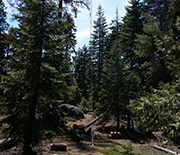News Release 18-029
Billions of gallons of water saved by thinning forests
Too many trees in Sierra Nevada forests stress water supplies, scientists say

The 2013 Rim Fire, the largest Sierra Nevada fire to date, cost more than $127 million to fight.
April 23, 2018
This material is available primarily for archival purposes. Telephone numbers or other contact information may be out of date; please see current contact information at media contacts.
Find related stories on NSF's Critical Zone Observatories webpage.
There are too many trees in Sierra Nevada forests, say scientists affiliated with the National Science Foundation (NSF) Southern Sierra Critical Zone Observatory (CZO).
That may come as a surprise to those who see dense, verdant forests as signs of a healthy environment. After all, green is good, right? Not necessarily. When it comes to the number of trees in California forests, bigger isn't always better.
That's in part because trees use lots of water to carry out basic biological tasks. In addition, they act as forest steam stacks, raking up water stored in the ground and expelling it as vapor into the atmosphere, where it's accessible to humans and forest ecosystems only when it falls back to Earth as rain and snow.
That process -- by which plants emit water through tiny pores in their leaves -- is known as evapotranspiration. And according to researchers, excessive evapotranspiration may harm a fragile California water system, especially during prolonged, warm droughts.
New research published this week in the journal Ecohydrology shows that water loss from evapotranspiration has decreased significantly over the past three decades. That's due in large part to wildfire-driven forest thinning -- a finding with important implications for forest and water management.
A century of forest management had kept wildfires to a minimum. But without fire, Sierra forests grew very dense. In recent decades, new policies have allowed nature to take its course, with wildfires helping to thin out overgrown forests.
"Forest wildfires are often considered disasters," said Richard Yuretich, director of NSF's CZO program, which funded the research. "But fire is part of healthy forest ecosystems. By thinning out trees, fires can reduce water stress in forests and ease water shortages during droughts. And by reducing the water used by plants, more rainfall flows into rivers and accumulates in groundwater."
Using data from CZO measurement towers and U.S. Geological Survey satellites, researchers found that over the period 1990 to 2008, fire-thinned forests saved 3.7 billion gallons of water annually in California's Kings River Basin and a whopping 17 billion gallons of water annually in the American River Basin -- water that would otherwise have been lost through evapotranspiration.
Forest thinning has increased in recent decades in an effort to stave off disastrous wildfires fueled by dense forests. This study shows that restoring forests through mechanical thinning or wildfire can also save California billions of gallons of water each year.
"The need for forest restoration is being driven largely by the need to lower the risk of high-intensity wildfires and restore forest health," said University of California Merced scientist Roger Bales, director of the Southern Sierra CZO and study co-author. "Downstream users who benefit from the increased water yield are an important potential revenue stream that can help offset some of the costs of restoration."
Forested areas needing restoration are large, Bales said, but potential changes in water availability are significant. The total effect of wildfires over a 20-year period suggests that forest thinning could increase water flow from Sierra Nevada watersheds by as much as 10 percent.
The U.S. Forest Service says that 6 to 8 of the 21-million acres it manages in California need immediate restoration. Another 58 million acres nationally also require restoration. For California alone, restoration costs are estimated at $5 to $10 billion. But, according to the study authors, the restoration might help pay for itself.
"We've known for some time that managed forest fires are the only way to restore the majority of overstocked western forests and reduce the risk of catastrophic fires," said James Roche, a National Park Service hydrologist and lead author of the new study. "We can now add the potential benefit of increased water yield from these watersheds."
-NSF-
-
Tower at NSF's Southern Sierra CZO measures exchange of water, carbon between forest and atmosphere.
Credit and Larger Version -
A restored forest grows in the foreground, with a dense, unthinned forest in the background.
Credit and Larger Version -
Low-intensity controlled burns reduce fire spread and result in small changes in forest water use.
Credit and Larger Version -
Mixed-conifer forest one year after a high-intensity fire in the Tahoe National Forest.
Credit and Larger Version -
Mixed-conifer forest one year after a medium-intensity fire in Yosemite National Park.
Credit and Larger Version
Media Contacts
Cheryl Dybas, NSF, (703) 292-7734, email: cdybas@nsf.gov
Jason Alvarez, UC-Merced, (209) 228-4483, email: jalvarez78@ucmerced.edu
The U.S. National Science Foundation propels the nation forward by advancing fundamental research in all fields of science and engineering. NSF supports research and people by providing facilities, instruments and funding to support their ingenuity and sustain the U.S. as a global leader in research and innovation. With a fiscal year 2023 budget of $9.5 billion, NSF funds reach all 50 states through grants to nearly 2,000 colleges, universities and institutions. Each year, NSF receives more than 40,000 competitive proposals and makes about 11,000 new awards. Those awards include support for cooperative research with industry, Arctic and Antarctic research and operations, and U.S. participation in international scientific efforts.
Connect with us online
NSF website: nsf.gov
NSF News: nsf.gov/news
For News Media: nsf.gov/news/newsroom
Statistics: nsf.gov/statistics/
Awards database: nsf.gov/awardsearch/
Follow us on social
Twitter: twitter.com/NSF
Facebook: facebook.com/US.NSF
Instagram: instagram.com/nsfgov





